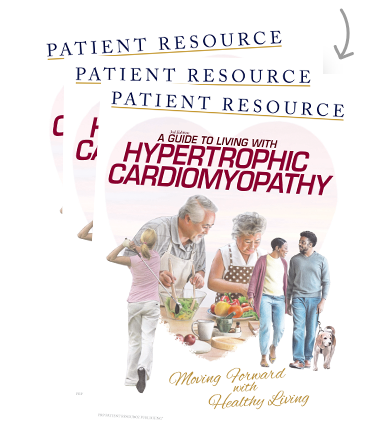Introduction
Knowledge is your biggest asset
When you receive a hypertrophic cardiomyopathy (HCM) diagnosis, education becomes vitally important. From understanding your diagnosis and finding a skilled medical team to guiding you to where to look for the most trusted resources, everything you learn will help you better manage this chronic condition and live your life to the fullest.
HCM is a type of obstructive heart disease that primarily involves a thickening of the wall (septum) between the two bottom chambers of the heart (see Figure 1). The walls of the left ventricle can also become stiff. This may block or reduce the blood flow from the left ventricle to the aorta, a large artery that carries oxygen-rich blood from the left ventricle of the heart to other parts of the body. This obstruction prevents the heart from carrying out its intended function.
When this occurs, it forces the ventricles to pump harder to overcome the narrowing or blockage. Additionally, the septum may bulge into the left ventricle and partially block the blood flow out of the heart to the rest of the body.
Both conditions cause the heart to work harder and may increase pressures in the heart, resulting in fatigue, shortness of breath and potentially heart failure.
Next Steps
Having a plan helps. Begin your journey by doing the following.
1. Consult with a team of HCM experts. Depending on the experience your current cardiologist and medical team have with diagnosing and treating HCM, they may recommend you get a first or second opinion from an HCM specialist or HCM treatment center. Look for an HCM Center of Excellence (COE). A treatment center must meet specific criteria to receive this designation. A COE typically employs a multi-disciplinary team to provide whole-person HCM care. If you are not located near an HCM COE, ask whether it is possible to arrange a consultation with your local medical team.
2. Learn about your heart. Familiarizing yourself with the components of the heart makes it easier to understand the parts that are not working as they should (see Figure 2).
The heart is a muscle that is about the size of a fist. It sits slightly to the left of the center of the chest. Along with blood and blood vessels, it makes up the cardiovascular system.
Blood is pumped throughout the body through blood vessels as the heart beats. It beats about 60 to 100 times per minute, sending oxygen and nutrients throughout the body and carrying away unwanted carbon dioxide and waste products. Electrical signals tell the heart muscle when to contract and relax and ensure it continues to pump regularly.
The two top chambers of the heart – the right atrium and left atrium – receive incoming blood. The two bottom chambers, the right ventricle and the left ventricle, pump blood out of the heart. The chambers are separated by a wall of muscular tissue called the septum.
The heart also has four valves — one for each chamber of the heart. They open and close to let blood flow through the heart and keep it moving in only one direction. The mitral valve and tricuspid valve are located between the atria (upper heart chambers) and the ventricles (lower heart chambers). The aortic valve and pulmonic valve are located between the ventricles and the major blood vessels leaving the heart.
The walls of the heart are made of three layers. The endocardium is the thin membrane that lines the interior of the heart. The middle layer of the heart is the myocardium, which is the heart muscle and the thickest layer of the heart. The epicardium is a thin layer on the surface of the heart on which the coronary arteries lie.
The right atrium receives blood depleted of oxygen from the body and pumps it to the right ventricle to be sent to the lungs to pick up oxygen. The oxygenated blood from the lungs flows into the left atrium and is then transferred to the left ventricle, which pumps it around the body.
3. Adjust your mindset and find support. Although you will manage HCM for the rest of your life, it does not have to define you. And, it is not something to face alone. Surround yourself with a support system. Build your supportive community by exploring HCM advocacy and support groups. Sharing with and learning from people who live with HCM can offer valuable practical advice and be a source of hope.





